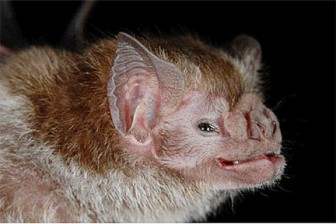Vampire bats, creatures of many myths and legends, are blood-feeding, flying mammals found throughout Central and South America. There are three species: the Common Vampire Bat, the White-winged Vampire Bat and the Hairy-legged Vampire Bat, but only the first two species are found in Guyana. The White-winged Vampire Bat was first scientifically described from a specimen collected in the county of Berbice, however the most well known of the vampires is the Common Vampire Bat.
![]() Common Vampire Bats are distinguished by their short, conical, rosette noses and elongated thumbs. The thumb helps to provide balance as the bat approaches stealthily along the ground towards it prey. Unlike common belief, vampire bats don’t suck blood out of their prey but rather make a small cut in the skin of sleeping animals using their sharp teeth and lap the blood as it oozes out. The saliva of vampire bats contains enzymes which act as an anti-coagulant, allowing the blood to flow freely. In fact, scientists believe that this enzyme is the most effective anti-coagulant in the world, and may some day be used to prevent stroke and heart attacks.
Common Vampire Bats are distinguished by their short, conical, rosette noses and elongated thumbs. The thumb helps to provide balance as the bat approaches stealthily along the ground towards it prey. Unlike common belief, vampire bats don’t suck blood out of their prey but rather make a small cut in the skin of sleeping animals using their sharp teeth and lap the blood as it oozes out. The saliva of vampire bats contains enzymes which act as an anti-coagulant, allowing the blood to flow freely. In fact, scientists believe that this enzyme is the most effective anti-coagulant in the world, and may some day be used to prevent stroke and heart attacks.

Vampire bats live on their own or in colonies made up of several thousand individuals, in caves, wells, trees and buildings, perhaps also sharing with other bat species. Vampire bats are highly social creatures. They have a nursery system to take care of the young and they share food with each other, feeding members of the colony who did not find food in the night. This is especially important as they can only survive around two days without a meal. They are also one of the bat species known to groom each other.
Rain forests are rich in biodiversity and are home to many different plants and animals. Indigenous communities also live there. Even if you don’t live in the rain forest, humans rely on the forest for resources such as building materials (wood and lianas), medicine and fruits. Rain forests also provide essential environmental services for life on earth; they create soil as well as prevent soil erosion, produce oxygen though photosynthesis, maintain clean water systems, and are a key defence against climate change.
The Iwokrama Rain Forest is 371,000 hectares, located in the heart of Guyana. Our mission is to develop strategies for conservation and sustainable development for local people in Guyana and the world at large. We are involved in tourism, training, research and our timber is certified by the Forest Stewardship Council. Come and visit us in the rain forest or at http://www.iwokrama.org.





